When we got to Tennessee we thought we would visit Nashville, just not like we planned.
After we settled in, Carol took a look at things to do in the area... what about the Parthenon? (https://www.nashvilleparthenon.com).
That's right... the Parthenon. This is the only building that was rebuilt from Tennessee's Centennial Exposition of 1897. The area didn't start out as Centennial Park though; in 1783 it was part of a 640 acre farm, purchased for $.50 an acre. Before it became the location for the Exposition, it was fairgrounds, and a racecourse.The Parthenon was one of a whole community of buildings built to scale for the Exposition, designed and constructed to last only six months, the length of the Exposition. All the buildings with the exception of the Parthenon were dismantled. A newly formed Parks Board acquired the property in 1901, and opened Centennial Park in 1903. Being the building was made of wood and plaster, it required a lot of maintenance, and round 1920 it was decided that there needed to be a permanent solution, either tear it down, or rebuild it. The Parks Board chose to rebuild it.
the Williamson Chapel was located in the northern part of Rutherford county. Like most chapels in their time, genders were segregated, and a preacher probably visited two times a month. Today the chapel is used for weddings.
The reconstructed exterior was made from the newest twentieth century materials, such as reinforced concrete, for the roof, expanded walls, and load-bearing columns. The brick walls and non load-bearing columns were kept and incorporated in the new construction. Construction was slow, due primarily because of funding; the exterior of the building wasn't completed until 1931, when they opened it to the public. When the Parthenon opened to the public it was still missing two things, the statue of Athena, and the Frieze on the exterior of the building.
The first floor contains the history of the Centennial Exposition, art collections (during our time it was the Cowan collection), and a collection by Lynn Goldsmith called The Looking Glass.Her exhibit motivation was turning the camera on herself, questioning what was real, and what was imagined. These photographs are different in the way the photos were done. A standard photo is a developed snapshot of a moment in time, Lynn's photos can have up to 50 photos put together to make one photograph. You can go to the Parthenon website, click the Education tab, and scroll down to the Looking Glass link.
For some reason I do not have any of my photos from the Cowan Collection exhibit, but you can do the same as the recommendation for Looking Glass, only scroll down to the Cowan Collection.
There are a few virtual collections from past artists as well.
Onward and upward to the second floor, where a statue of Athena can be seen. It took awhile for Athena to show up.
Donations were accumulated for the construction of the Athena statue, and the Parks Board commissioned the creation of the statue in 1982. This was to be a replica of the of the original statue that stands 42 feet.The creation of the new statue took eight years to complete, and that did not include the gold gilding, and unveiled in 1990. It took 12 years more of donations before the gilding was accomplished... so what you are looking at has only been since 2002.
There is debate by the scholars about the original Greek Athena Parthenos. It is believed that the original was made using gold plates weighing approximately 44 talents (2,400 pounds), on a wooden armature, ivory, painted skin tone for arms and face, and gemstones inset for her eyes. The Athena before visitors in Nashville is covered in thin layers of gold weighing in at a total of approximately eight pound... big difference.
How about a little history lesson regarding the myth of Athena... you're gonna get it anyway.
As Greek mythology has it, Athena is the goddess of wisdom, useful arts (whatever that meant), and protector of cities. Her title Athena Parthenos referred to her status as a maiden goddess; Parthenon, translated to English means, "the house of the maiden". She was born from the head of Zeus, inheriting much of his wisdom and power. In Athena's right hand is the goddess Nike, who is about to crown Athena with a laurel wreath.
Let's talk about Athena's garnishments.1) Her helmet. The crest is supported by three mythological creatures: right and left are Pegasus', and a sphynx in the middle. 2) The shield for protecting the snake, or people of Athens. 3) The serpent represents Ericthonios, a legendary defied king of Athens; again a representation of the people of Athens. 4) Her sandals are decorated with scenes depicting the slaying of Centaurs. 5) The Frieze, depicts the birth of Pandora, meaning "all gifts". The figures in order left to right: Helios, Hermes, Hera, Zeus, Nike, Dionysus, the three Horai (hours or seasons), Pandora, Hephaistos, Athena, Poseidon, Artemis, Apollos, Ares, Demeter, Hestia, Eros, Aphrodite, and Selene. Phew, that's all of them. 6) The Aegis. The breastplate she wears on her shoulders was believed to be magical. It was given to her by Zeus, making her impervious to her enemies' weapons. In the center of the breastplate is the head of Medusa, given to her by Perseus, for her assistance in killing Medusa.
There is definitely a story on the shield. This shield is 15 feet in diameter. The exterior is a relief depicting the battle between the Greeks and the Amazons. The center is an image of Medusa. The interior of the shield depicts a battle for supremacy between the Greeks and their predecessors, the Giants of Titans.
Entry into the original temple would have been through bronze doors, 24 feet tall.These doors are so heavy, there are tracks in the floor to help open the doors. From the Naos (where Athena is standing), we walked to the another room behind the Naos, called the Treasury. During a remodel, openings were created to get between the Naos and Treasury. In this room was a display of pediment sculptures on the outside of the Parthenon.
After visiting the Parthenon we were going to catch the trolley from Centennial Park to downtown Nashville... didn't happen... the trolley service didn't run that day. So we hopped into the truck and drove downtown, and right on through. Carol and I are not lovers of traffic, which includes too many people. We did find other things to see around the Nashville area.
We took a drive out to the Stones River Battlefield. The best starting point is the Visitor Center/Museum. There is a short video about the battlefield, then a walk through the small exhibit hall, and out onto the trails. This was a significant battle at the beginning of the Civil War, between December 31st 1862, to January 2nd, 1863.
Remember, the government had been compromising for several decades.As you can possible see from the charts above, it went from a division line, to territories making choices.
It was Lincoln's belief that Tennessee was the bridge to the South. Middle Tennessee was the supply point of guns, ambulances, harnesses, and food to the Confederate soldiers. The Union Army's plans were to use the railroads to defeat Confederate forces.
Stones River was a prime example of family fighting against family. A third of the soldiers were from Tennessee, the rest from other southern states, other than Virginia. The Union army forces were from states west of the Appalachian mountains, primarily from Tennessee, Kentucky, and Missouri. In three days of fighting, there were 23,525 soldiers were either killed, wounded, or captured. the Union's casualties amounted to 13,259, and Confederate came in at 10,266; many of the wounded would later die of their injuries.
Stones River was a prime example of family fighting against family. A third of the soldiers were from Tennessee, the rest from other southern states, other than Virginia. The Union army forces were from states west of the Appalachian mountains, primarily from Tennessee, Kentucky, and Missouri. In three days of fighting, there were 23,525 soldiers were either killed, wounded, or captured. the Union's casualties amounted to 13,259, and Confederate came in at 10,266; many of the wounded would later die of their injuries.
There are trails emanating from the Visitor Center, and visitors can drive a tour to multiple sites. As we drove through the battlefield, it wasn't hard to imagine the troops hunkered down in the fields and behind trees, bullets and cannon balls flying everywhere. Imagine bitter cold of winter soaking through your bones... and being advised not to have fires for warmth... because the enemy might shoot into the flickering flames of warmth. During the New Year's truce, the soldiers mingled amongst each other, burying their dead, and digging fortification for battle after the truce was over.
General Rosecrans got himself in hot water sitting here near Murfreesboro in Nashville. Nashville was a secure center where steamboats and railroads could drop off supplies they hauled for the Union Army. General-in-Chief Halleck advised him that if he did not make efforts to march southward, he would be replaced.
Across the street from the Visitor Center is a national cemetery, where both Union and Confederate soldiers are buried.Walking the cemetery, there were a lot of stones that had the word "unknown" on them. This young man, one of several I found, was only 14, when he was killed fighting for his beliefs. This young man was a Union soldier, probably a drummer, or carried his company's flag.
One leg of the driving tour was around the Visitor Center and cemetery, which encompassed the largest part of the battlefield. Another stop was Hazen Brigade Monument, located on a section of the battlefield known to the soldiers as "Hell's Half Acre". At the back of the property is a monument to the men that died .
The monument is a four-sided memorial to the soldiers buried here.
The soldiers buried here were under to Command of Colonel William Hazen, and were from: 6th Kentucky Volunteer Infantry, 41st Ohio Volunteer Infantry, 9th Indiana Volunteer Infantry, 110th Illinois Volunteer Infantry, and Battle "F" First Ohio Light Artillery. There several unknown soldiers buried here as well.
We had to hop back into the truck, and headed to the next tour site, several miles away.
The monument is a four-sided memorial to the soldiers buried here.
The soldiers buried here were under to Command of Colonel William Hazen, and were from: 6th Kentucky Volunteer Infantry, 41st Ohio Volunteer Infantry, 9th Indiana Volunteer Infantry, 110th Illinois Volunteer Infantry, and Battle "F" First Ohio Light Artillery. There several unknown soldiers buried here as well.
We arrived at McFadden Farm, which was the final confrontation along Stones River. Imagine yourself fighting on the Confederate side, a cold January 2nd, in 1863. Across from your vantage point you see a line of cannons stretching the length of seven football fields (uncommon at any point during the Civil War). The Confederate forces have been given the order to approach McFadden Ford, 58 cannons looking at you from the knoll. The Union Army is given the order to fire, and the sound of those cannons firing in unison is intimidating, laying siege to the forests you are attacking from, and trees are crashing around you. In a short moment in time (less than an hour), 1800 of your comrades lay dead, or wounded on the battlefield, and the rest of you are scurrying in retreat, stepping over fallen comrades. The realization of this battle was that the Confederate soldiers never even made it to the waters edge to attack.
The Nashville, Chattanooga & St. Louis Railway played a big part in memorializing the Civil War. They bought land near the rails running along battles, and erected monuments. This monument was erected at McFadden Farm.
John W. Thomas, the Nashville, Chattanooga & St. Louis Railroad president was one of the champions that encouraged memorializing the Civil War, scheduling tours of the southern battlefields. Stops at cemeteries, visitors could step off the train platforms, and enter hallow ground, to pay respects to the fallen soldiers of the North, and South.
We worked our way back home, and new neighbors were coming in. Our new neighbors were Arctic Fox fans too, theirs was a camper. While talking to them we all got a new experience... meeting the Red Velvet Ant a.k.a. Cow Killer Ant.The photo is a bit blurry, these suckers are fast movin'. I had to look it up, and learned that they are not actually an ant, they are a form of wasp, with a nasty sting. Our introduction was to a female... how do I know... I looked it up. The females are brightly colored, and wingless; the males have wings. One advantage to dealing with the male, is that it does not sting, the female does, and are also known to be solitary insects.
Our journey out the next day took us to Murfreesboro, containing a reproduction 19th century community called Cannonsburgh Village. A lot of towns were built around water, whether it be a spring, creek, river, or lake. Before entering Cannonsburgh, it was necessary to cross over an iron bridge. This bridge originally crossed over Stewart Creek.
Our journey out the next day took us to Murfreesboro, containing a reproduction 19th century community called Cannonsburgh Village. A lot of towns were built around water, whether it be a spring, creek, river, or lake. Before entering Cannonsburgh, it was necessary to cross over an iron bridge. This bridge originally crossed over Stewart Creek.
Back to Murfreesboro for a minute. Most of the roads out of Murfreesboro were toll roads, with these tollgates. Each tollgate was operated by the family that lived in the tollgate house.
Back to Cannonsburgh Village. This community is a representation of buildings between 1800 to 1925. The original Cannonsburgh was created when it was decided that a more centrally located Rutherford county seat needed to be created.Walking through the gate, the first building we came to was the Grist Mill.This grist mill is a scaled down representation of mills that played an important role to settlers. Machinery in this mill is from an abandoned 150 year old mill in northern Alabama, including these grinding stones.
Moving on to the next building we find a one room schoolhouse. The schoolhouse is on site is a reconstruction, made from large logs of a corn crib that was located in southern Rutherford county.The kids would be separated by grade, and gender. Their lessons may have been ten to fifteen minutes long, with at least three recesses.
Back in the day when telephones were just coming into homes in the early 1900s, calls were handled through a local switchboard, open 24/7. The telephone office was not only work, but home too. Rockvale Home Mutual Telephone hired Mrs. Ada Holton in 1918 as their first regular operator. most of the furnishings in this building belonged to "Miss Ada".Ada was a widow with a child, and continued to be the operator for another 25 years, until her health took a turn.
Home remodeling was a little different back in the mid 19th century. Today we knock out a wall and add another room, back then it was a bit more difficult.This house was originally on the Middle Tennessee State University campus. When the house was first built it would have most likely only be a one-room abode. When the family grew, it was necessary to enlarge, and that occurred when a second one-room abode was built a few feet away. The two rooms were connected via a "dogtrot", with a roof that connected the two structures.There was thought when it came to adding on. The add-on would be built so that the fireplaces were on outside walls, to prevent the home from overheating during cooking. In the summer months, cooking would be done in the "dogtrot".
I knew that our ancestors used lye soap for bathing and washing clothes, I didn't know how it was made though.I never thought that the lye came from water sifting through ashes. The ashes would be stored until soap-making season. the ashes would be soaked with water, after several hours the lye would drain through the ashes into the bottom of the hopper. Animal fats were added to the lye, boiled, and cooled, until solid.
This is the Leeman House. This was a typical Tennessee log cabin built in the 1820s. The second floor rear section of the cabin was an addition around the 1870s. The front upstairs area would have been the girls would have slept, the back portion of the second floor would have been where the boys slept; there was no connecting door between the two sections of the second floor.
This is the Leeman House. This was a typical Tennessee log cabin built in the 1820s. The second floor rear section of the cabin was an addition around the 1870s. The front upstairs area would have been the girls would have slept, the back portion of the second floor would have been where the boys slept; there was no connecting door between the two sections of the second floor.
The Leeman house would have had outside toilet facilities, and a smokehouse. The Leeman House now has modern cooking facilities to support wedding receptions.
the Williamson Chapel was located in the northern part of Rutherford county. Like most chapels in their time, genders were segregated, and a preacher probably visited two times a month. Today the chapel is used for weddings.
Some communities would have a central location to do loom work, this community is no different.This one was originally built in the early 1800s, and resided in Rutherford county; it was moved from its original location to Cannonsburgh Village in 1975. all items are authentic and exact to the era.
Larger small communities might have a doctor, Cannonsburgh did, nothing fancy of course. Small towns had general stores as well, they were called "general" because they carried a variety of merchandise, acted as the post office, and furniture store.In the early 20th century the village had a gas station, which is now the Stones River Car Club. With all the agriculture in the area, there were lots of tractors. A shed was built to display assorted tractors working the fields.
It was fun walking this little community, but it was time to head to lunch, and we did.
Lunch for the day was at Jack Brown's Beer & Burger Joint.
It wasn't the food, which was good, but the atmosphere that took center stage. They had a variety of beers on tap, as well as rotated crop of canned beers. On the walls were records of people who drank an exorbitant amount of beers, of different flavors, which came with pictures. When you look at the forms, we are talkin' 50 different beers per page, some of the drinkers have exceeded 500 bottles. Then there is the bra chandelier... women voluntarily give up their bras... the establishment donates $100.00 to breast cancer awareness. The Pink Floyd artwork is all bottle caps. This place was a fun eating establishment.
It was fun walking this little community, but it was time to head to lunch, and we did.
Lunch for the day was at Jack Brown's Beer & Burger Joint.
It wasn't the food, which was good, but the atmosphere that took center stage. They had a variety of beers on tap, as well as rotated crop of canned beers. On the walls were records of people who drank an exorbitant amount of beers, of different flavors, which came with pictures. When you look at the forms, we are talkin' 50 different beers per page, some of the drinkers have exceeded 500 bottles. Then there is the bra chandelier... women voluntarily give up their bras... the establishment donates $100.00 to breast cancer awareness. The Pink Floyd artwork is all bottle caps. This place was a fun eating establishment.
To properly digest lunch, we took a walk around downtown Murfreesboro. One of the first things I learned about Murfreesboro, was it was the capitol of Tennessee from 1819 to 1825. Murfreesboro was first called Cannonsburgh, then Murfreesborough, and finally Murfreesboro. This was the county seat for Rutherford County. The county was named after General Griffith Rutherford, who served in the Revolutionary War, as Commander of the forces west of the Alleghany Mountains.
For a short time Murfreesboro was under Union control in March of 1862. the Union forces took over the courthouse and hoisted the United States flag above the courthouse. The Union soldiers were ordered to search homes and remove all firearms and ammunition, the citizens were required to agree to a "loyalty oath", and issued military passes. Those locals that were considered disloyal, were imprisoned in Nashville.
Union forces were separated into three detachments, one protecting the courthouse, one at Stones River, and one at Maney Springs.
July 1862 brought about a change for Murfreesboro, when Confederate forces led by General Nathan Forrest surprised Union forces, who held them off, until the Confederates threatened to burn the Union out of the courthouse. General Crittenden was captured, and union forces surrendered. Locals that were being held as hostages in retaliation for killing Union soldiers were set free.
Before we gave up the ghost in Tennessee, we stopped to visit the Oaklands Mansion. Head to: https://www.oaklandsmansion.org for excellent information.I took this photo in front of the oak trees.Circa 1930.
Circa early 1800s. This mansion was built pre Civil War, and had slaves. None of the slaves were ever sold of the plantation.
The mansion was originally built and owned by the Maney family. The Maney family had approximately 250 enslaved people dispersed between their three plantations, two in Mississippi, and this one in Tennessee.This front hall was not a part of the original plantation house, it was not built until 1859. Grand halls like this were designed to impress visitors while they were waiting to be invited into other rooms.
Before we gave up the ghost in Tennessee, we stopped to visit the Oaklands Mansion. Head to: https://www.oaklandsmansion.org for excellent information.I took this photo in front of the oak trees.Circa 1930.
Circa early 1800s. This mansion was built pre Civil War, and had slaves. None of the slaves were ever sold of the plantation.
As a visitor to this home, you would have been greeted by a negro butler, John Wesley Maney, who was a slave at another plantation down the road. After the Civil War he became the butler for Mr. and Mrs. Darrow. Being a freedman did not make him an equal. Some of the rules that he had to follow were: "yes sir", "yes ma'am"; was not to speak, unless spoken to; and serve the visitors. John served everything on a silver tray, from food and drinks, to mail; a negro man was not allowed to touch a white man's hand. He never was to look eye to eye with a white man, always required to look down at the floor. Sometimes I think things haven't changed much in the last 150 years.
Visitors would have been directed into one of two rooms initially, the Library, or the Front Parlor. Let's start with the Library.The Library would have been where Dr. Maney and his son, Lewis, would have managed the finances of the plantation from here. Part of managing the plantation, was also managing their enslaved field workers. Besides their own slaves, they traded in slaves; documents from the 1850s indicated they made a very large profit from human trafficking.
On to the Front Parlor.Now, the Front Parlor was not for everyday use, only special occasions, or entertaining important guests. Some of the special occasions ranged from Dr. Maney's funeral, in 1872, to the marriage of his great-great granddaughter in 1968. The plaster cornice, ceiling medallion, mahogany pocket doors, oak floors, and cherry accents, survived vandalism in the 1950s.
A women's group (Oaklands Association) took up the fight to preserve this wonderful mansion, a piece of history, running on mostly donations. What was vandalized was replaced with era appropriate materials from other structures being torn down in the area.
Well, here we are in the Rear Parlor.While the Maney's lived here they used the room as a sitting room, as well as the dining room. The later owners of the home used the room solely as a dining room. If you look over to the fireplace, you may notice another fireplace screen, this one was bigger than the one we saw earlier, and a little fancier too.The family dining room.
The family dining room fed the Maney family three meals a day, and was the business center for Adeline Maney. She managed the children, ordering supplies, entertain guests, managed the house enslaved personnel, and was the faithful wife. The door to the left of the fireplace led to the kitchen, via a breezeway.
Dr. Maney was Rutherford's earliest practicing physician, and had an office at Oaklands. He didn't spend much time practicing medicine, he found more profit selling and managing his slaves, and property interests.
By 1884, the Maney family sold Oaklands farm to a Elizabeth Swoope. Upon her death, the farm and mansion were willed to her daughter, Tempe. In 1890 Tempe and her husband George Darrow, made into the mansion and called it their home. Mrs. Darrow hired teams to install electricity, plumbing, and redecorate the interior of the mansion. The Darrows chose to rename the plantation, calling it Oak Manor. It's believed that Tempe grew tired of the rural life, so George built her a house in downtown Murfreesboro. Around 1912 they sold Oak Manor to the Roberts, and moved to town.
In the 1960s there was a fire that did quite a bit of damage to the mansion, putting to question if it could be restored. Slowly the mansion is being put back together. The breezeway and kitchen do not currently exist, but are in the works in the future, as funding permits.
Earlier I mentioned that the Union forces were separated into three detachments, one of the areas being Maney Springs, which was the Oaklands plantation. The family watched with joy as the Confederate army defeated the Union troops.
Time to head back home and prep for another state. Tennessee is definitely a return visit.


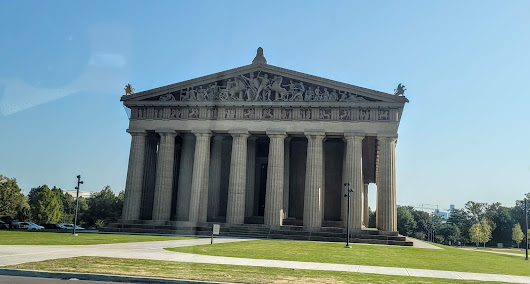









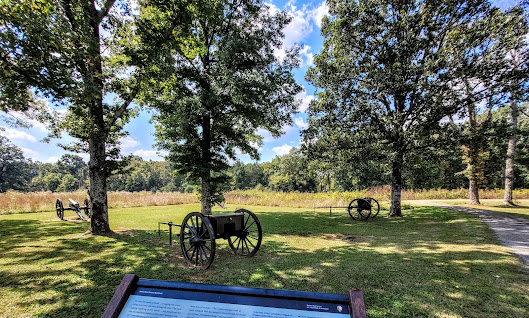














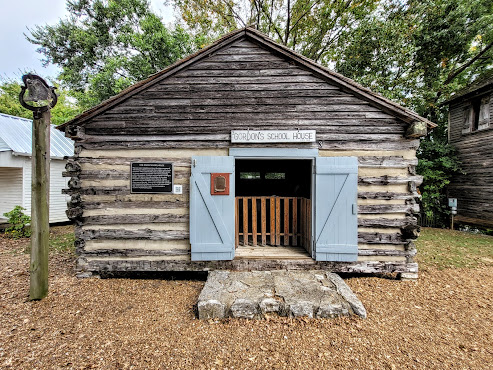



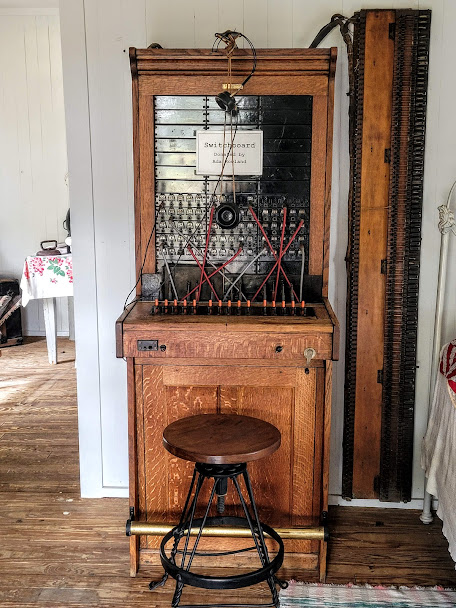























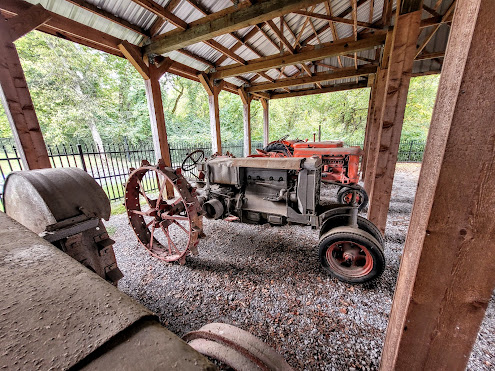



















No comments:
Post a Comment